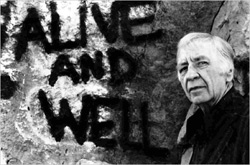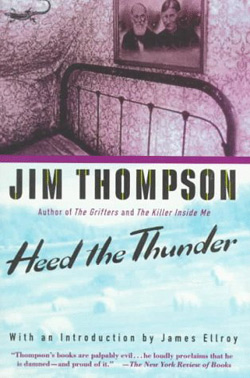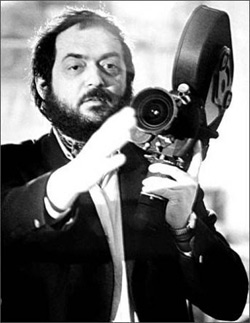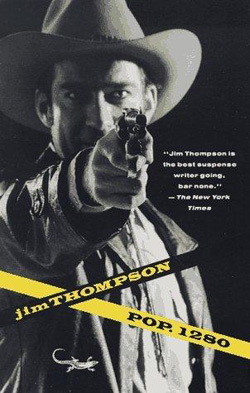
Film history is full of novelists wanting to make it in Hollywood, or at least hoping for a steady paycheck, but falling far short. Even those who managed success in film and in print, say William Faulkner, got fed up with Hollywood and returned to their books.
In this post I’m going to look at Jim Thompson’s particularly troubled relationship with Hollywood, and in my next post I’ll look at the various film adaptations of his work. For more on Thompson’s life readers should immediately find a copy of Robert Polito’s magisterial Savage Art: A Biography of Jim Thompson.
Big Jim’s experiences in Tinseltown seem to have had a direct effect on his creative output and may even have contributed to his death. In Hollywood, Thompson met rejection, disappointment, frustration, emasculation, dashed hopes and—wait a minute, this is starting to sound like one of his novels. And well it should. Thompson’s time in La-La-Land began, as his novels often did, with what seemed like a great break.

Eventually, Thompson was snared by Lion Books’ factory and on their fiction assembly line he cranked out at least ten novels in less than two years. [Thompson wrote so quickly, and there was such a delay between writing and publication, that it becomes difficult to know for sure when Thompson wrote his novels in this hugely productive period. For example, Robert Polito claims that The Kill-Off was written in 1953, even though it wasn’t published until 1957.] These novels include most of his classics, including Savage Night, The Kill-Off, A Hell of a Woman, and The Nothing Man. After 1955, though, both Thompson’s productivity and the quality of his work dropped off sharply. Thompson’s alcoholism and depression also steadily increased, and he wrote far fewer great novels after 1955 than before.
But something else happened in 1955—Jim Thompson moved to Los Angeles.

It seems that a personal arbitration was struck between Thompson and Kubrick who agreed to pay Big Jim for adapting Paths of Glory. This time Thompson insisted on a clause in his contract stating the credits would read “Screenplay by Stanley Kubrick and Jim Thompson.”
But with depressing predictability Paths of Glory soon ran into its own writing credit fiasco between Kubrick, Thompson, and famed screenwriter Calder Willingham (One-Eyed Jacks, The Graduate). Willingham later asserted that he wrote 99% of the screenplay, Kubrick wrote 2 lines, and Thompson none. This outlandish claim has been challenged by Robert Polito who looked over the different drafts of the screenplay and concluded that Thompson wrote roughly half the dialogue. In the credits, Thompson’s name would eventually be listed third.
Thompson never moved away from Los Angeles, but the movie studios never welcomed him back. The novels were slow in the writing and weren’t selling as well as they used to, so to make money Thompson sold teleplays to shows such as: Tales of Wells Fargo, Mackenzie’s Raiders, Dr Kildare, Combat, Convoy, and Ironside.
Over the rest of his life several of his novels were nearly adapted to film. A string of directors, including Orson Welles, Claude Charbol and Jean-Luc Godard all expressed interest in either adapting a novel or working with him—yet none of the deals went through. Thompson even wrote a screenplay with Robert Redford, based somewhat on South of Heaven, but the project stalled.
Thompson published twelve novels after Paths of Glory was released in 1957. This is still an impressive output, but when you look at his bibliography, it’s clear that something changed in Thompson after Hollywood got its hooks into him.

Bad Hollywood deals hounded Thompson right up to his deathbed. Burt Kennedy’s tepid 1976 adaptation of The Killer Inside Me humiliated Big Jim. Thompson had sold the movie rights years earlier in a deal that paid him very little. He spent the last year of his life complaining about the money and what Kennedy did to his most cherished novel.
Tomorrow I’ll look at the ups and downs (mostly downs) of the various attempts to adapt Thompson’s work for the big screen. But this post is where the heartbreak lies. Thompson crawled out of the Dust Bowl, survived the oil fields and survived as an alcoholic beginning in his teen years. At Lion Books he was handed plot outlines and told to write a novel. Thompson not only met the word counts, he produced gritty, beautiful fiction that cast a spotlight into the dark corners of the American psyche. His work still has the power to unsettle and shock even the most jaded of modern readers. But in the end, the one system he couldn’t beat was the dream factory. Sharon Thompson made her father’s anguish starkly clear when she told Robert Polito, “Hollywood killed Daddy.”
(For more, see Part 2)
Richard Z. Santos lives outside of Austin and is enrolled in the MFA program at Texas State University. Once, he worked in Washington, DC, but now he doesn’t do much more than write and teach. He blogs at Paperclip People, and is working on his first novel—a crime thriller set in New Mexico.

Great first part of the article… LOVE Big Jim Thompson. Once you discover him, you get really hooked on his style.
http://www.jukepopserials.com/home/read/32
@ John P.,
Yes! You’re absolutely right.
Personally, I read “The Killer Inside Me” when just a tender 16 and it was ‘love at first sight’ (or ‘first read’?). I’ve been addicted to reading his work ever since. I hasten to even refer to them as ‘pulp’, as I look on his work as neraly a post modern novelist; alneit one who just happened to work in the pulp field.
But I can attest to your statement that his style is throoughly addictive, one can definitely become ‘hooked’ on his style, his essence. It’s really a case of over-indulgence. . . binge reading!